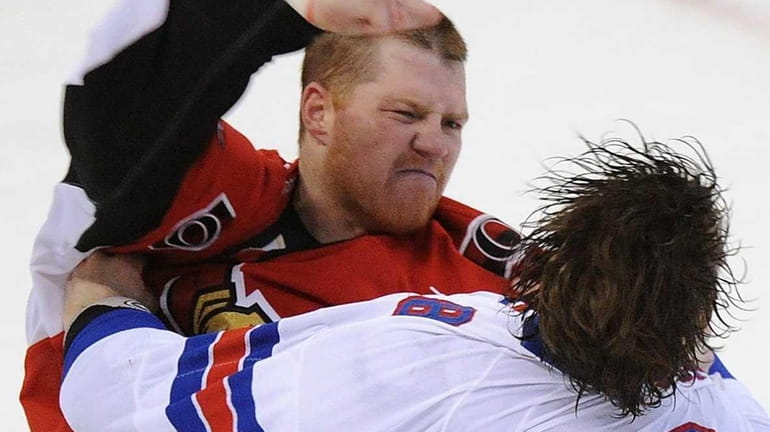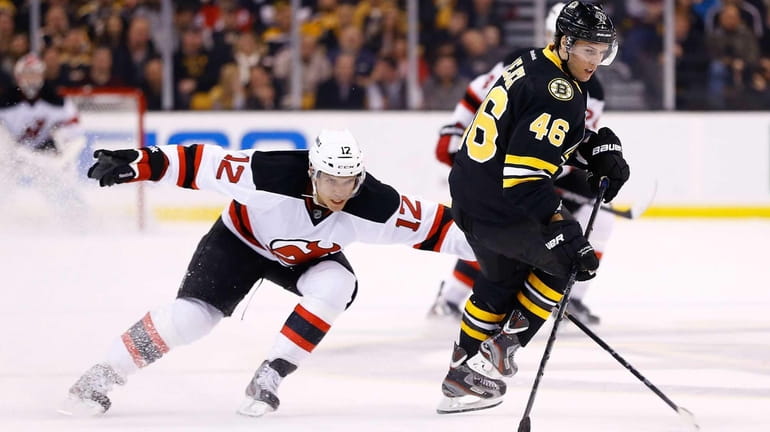NHL's Bettman defends the fisticuffs of his sport

Ottawa Senators' Chris Neil fights New York Rangers' Brandon Prust, right, during the first period of Game 6. (April 23, 2012) Credit: AP
A group of Associated Press sports editors, in their annual New York tour of commissioners' offices for state-of-their-sports updates last week, went to hockey headquarters and a fight broke out.
Well, not a fight really, but a lively discussion during which NHL chief Gary Bettman mostly defended the sport's fisticuffs.
Roughly two-thirds of the 90-minute session stayed on the related topics of player concussions, discipline of illegal hits, on-ice boxing matches and what Bettman acknowledged is the overall "physicality of the game," with its passion and intensity noticeably ratcheted up during the Stanley Cup playoffs.
With Brendan Shanahan, the league's head of safety, plenty busy reviewing recent on-ice nastiness, several old questions were raised: Should all fighting be banned? What is the rationale for allowing fights in the NHL when it is prohibited in such venues as the Olympics and European leagues? Why should the NHL remain the only major professional sports league that allows fighting?
All of which were generally rejected by Bettman as missing the point.
The NHL, he argued, was the first sports league to implement a study of concussions in 1997, with the sole purpose of improving player safety, and has implemented rules to eliminate all hits to the head. Fighting, he said, is "really one of the smaller components" leading to such injuries.
"Pucks to the head probably cause more concussions," Bettman said, "but I don't think anybody's advocating going to foam-rubber pucks."
Fighting has diminished somewhat in recent years -- 0.44 per game this season, compared to 0.64 in 2003-04, according to the website hockeyfights.com, which meanwhile serves to glorify that aspect of the game. And a study by the Sports Analytics Institute concluded that fighting has "no effect on winning."
Yet it persists, and Bettman, citing the sport's bumptious passion -- with its adrenaline-fueled ruggedness and speed -- noted that the sport is so popular that the NHL played to 95.6 percent of capacity this season.
"First of all, there are penalties," he said. "There are no bench-clearing brawls. So to suggest there are no consequences for fighting is inaccurate.
"You are taken off the ice if you fight. The difference is the degree to which you punish. You may be an advocate for stronger penalties and there are those which are advocates for weaker penalties, but I don't think it's either fair or appropriate to look at one element of the game and say, 'Well, I don't like that, I like everything else.'
"It's a part of the game. It's a small part of the game. It gets far too much attention. Most of our games don't have fights and . . . there is a perception that fighting, or the threat of fighting, acts as a bit of a thermostat and a deterrent of other things you might not want to see on the ice. It's a balance.
"There are some people who are strongly in favor of maintaining the status quo, there are some who think we should liberalize it and some who think we should penalize it more severely. And that will probably be an ongoing debate.''
Hockey yields to no sport when it comes to embracing an ecosystem of sturdiness. "This is a physical game played like no other," Bettman said. "At higher speeds, nonstop action. Contact is encouraged, players are carrying sticks. And there are different types of fights; many people believe that the so-called staged fight has outlived its usefulness.
"But the point being that an emotional, intense game like ours -- and, again, this is a small part of the game; this is not something that dominates the game nor frankly warrants the attention it gets -- it's been there from the start, and what is done at other levels [of the sport, where fighting is outlawed] isn't necessarily what's appropriate at the professional level.
"This notion that you want to pick certain things and take this out or that out . . . it's a living, breathing dynamic. You've got to look at it as a totality. We've changed the rules on fighting all the time. We try to monitor and evolve the game."
The meeting ended with handshakes all around.

